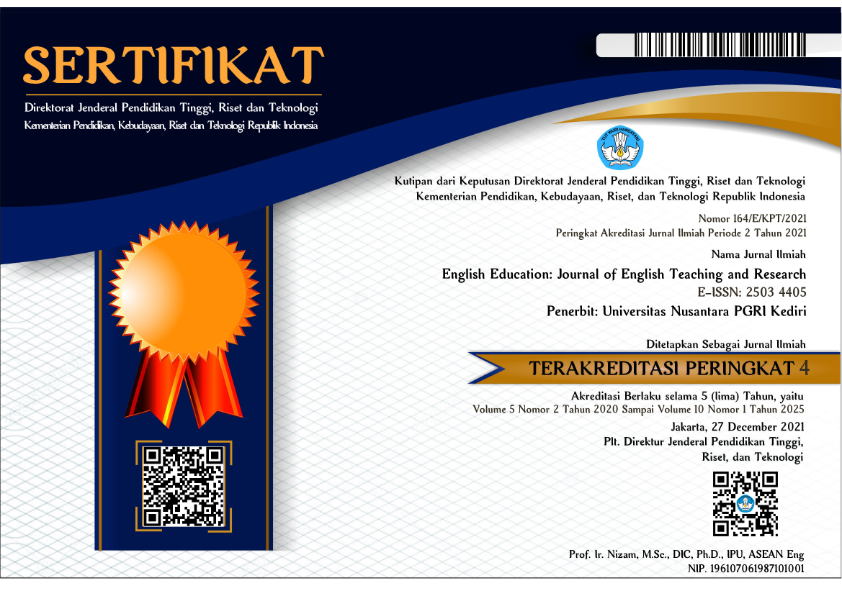YouTube as a Tool for English Language Learning
A Meta-Analysis in EFL Contexts
DOI:
https://doi.org/10.29407/jetar.v10i1.23641Keywords:
Effect Sizes, EFL, Secondary, Skills, University, Utilization, YouTubeAbstract
The purpose of this study was to investigate the use of YouTube as a tool for English language learning in secondary and university settings within English as a Foreign Language (EFL) contexts. The study included 81 empirical research journal papers published between 2015 and February 2024. The researchers evaluated article journals that met the criteria for inclusion in the review to gain insights into the utilization of YouTube in English Language Learning (ELL) in both university and secondary school settings, with a particular focus on its use in the EFL context. This study employed a simple statistical and analytical framework to analyze the existing data. The findings revealed that the most enhanced skill using YouTube was speaking. The initial number of articles obtained at the beginning of the process was 1054 articles. Then, screening was conducted according to the inclusion criteria and based on PRISMA, resulting in a final total of 81 articles. Calculations were performed by computing the effect size of each article individually and then averaging all of them using Microsoft Excel. The mean effect size from 81 articles is 1.24, indicating a very high impact on the use of YouTube as a tool for English language learning. The results also showed that the utilization of YouTube was categorized into platforms for producing content, flipped classroom, discussion platform, and media platform. Pedagogical and theoretical implications were suggested.
Downloads
References
Albahlal, F.S. (2019). The Impact of YouTube on Improving Secondary School Students’ Speaking Skills: English Language Teachers’ Perspectives. Journal of Applied Linguistics and Language Research, 6, 1-17.ja
Alkathiri, L. A. (2019). Students’ perspectives towards using YouTube in improving EFL learners’ motivation to speak. Journal of Education and Culture Studies, 3(1), 12. https://doi.org/10.22158/jecs.v3n1p12
Almurashi, W. A. (2016). The effective use of YouTube videos for teaching English language in classrooms as supplementary material at Taibah university in alula. International Journal of English Language and Linguistics Research (4).
Bahrani, T., Tam, S. S., & Zuraidah, M. D. (2014). Authentic language input through audiovisual technology and second language acquisition. SAGE Open, 4(3). https://doi.org/10.1177/2158244014550611
Bergmann, J., & Sams, A. (2012). Flip Your Classroom: Reach Every Student in Every Class Every Day. International Society for Technology in Education
Creswell, J. W., & Poth, C. (2017). Qualitative Inquiry and research design : choosing among five approaches
https://openlibrary.org/books/OL28633749M/Qualitative_Inquiry_and_Research_Design
Cohen, J. (1988). Statistical Power Analysis for the Behavioral Science. US: Lawrence, Erlbaum
Halwani, N. (2017). Visual aids and multimedia in second language acquisition. English Language Teaching, 10(6), 53. https://doi.org/10.539/elt.v10n6p53
Kessler, G. (2009). Student-initiated attention to form in wiki-based collaborative writing. Language Learning & Technology, 13(1), 79-95.
Mahrus, & Mariyatul Kiptiyah. (2024). The Effect of Video Blog (Vlog) to Students’ Speaking Skill on Junior High School . SELL (Scope of English Language Teaching, Linguistics, and Literature) Journal, 9(1), 65-75. https://doi.org/10.31597/sl.v9i1.1015
Nasr, E., & Mustafa, E. (2018). The Impact of YouTube, Skype and WhatsApp in improving EFL Learners’ Speaking Skill. International Journal of Contemporary Applied Researches, 5(5). Retrieved from www.ijcar.net
Nasution, A. K. R. (2019). YouTube as a media in English language teaching (ELT) context: Teaching Procedure text. Utamax, 1(1), 29–33. https://doi.org/10.31849/utamax.v1i1.2788
Nofrika, I. (2019). EFL students’ voices: The role of YouTube in developing English competences. Journal of Foreign Languange Teaching and Learning, 4(1). https://doi.org/10.18196/ftl.4138
O'Bannon, B. W., & Thomas, K. (2015). Teacher Pedagogical Beliefs: The Final Frontier in Our Quest for Technology Integration? Journal of Digital Learning in Teacher Education, 31(4), 127-135.
Pagano, R. R. (2012). Understanding statistics in the behavioral sciences. http://ndl.ethernet.edu.et/bitstream/123456789/34659/1/5.pdf.PDF
Page, M. J., McKenzie, J. E., Bossuyt, P. M., Boutron, I., Hoffmann, T. C., Mulrow, C. D., & Moher, D. (2021). The PRISMA 2020 statement: an updated guideline for reporting systematic reviews. International journal of surgery. 88(105906).
Pratama, S. H. H., Arifin, R. A., & Widianingsih, A. W. S. (2020). The use of YouTube as a learning tool in teaching listening skill. International Journal of Global Operations Research, 1(3), 123–129. https://doi.org/10.47194/ijgor.v1i3.50
Qomariyah, S. S., Permana, D., & Hidayatullah, H. (2021). The effect of YouTube video on Students’ listening comprehension performance. Jo-ELT (Journal of English Language Teaching) Fakultas Pendidikan Bahasa & Seni Prodi Pendidikan Bahasa Inggris IKIP, 8(1), 67. Retrieved from https://doi.org/10.33394/jo-elt.v8i1.3837
Rahmati, J., Izadpanah, S., & Shahnavaz, A. (2021). A meta-analysis on educational technology in English language teaching. Language Testing in Asia, 11(1). https://doi.org/10.1186/s40468-021-00121-w
Syaripuddin., Rahmatullah, R., & Rasyid, A. (2023). YouTube-Based Materials: Students’ Perception in English Listening Classroom. Journal of Applied Linguistics. 2. 17-28. 10.52622/joal.v3i1.123.
Van, L. K., Dang, T. A., Pham, D. B. T., Vo, T. T. N., & Pham, V. P. H. (2021). The Effectiveness of Using Technology in Learning English. AsiaCALL Online Journal, 12(2), 24-40. Retrieved from https://asiacall.info/acoj/index.php/journal/article/view/26
Zawacki-Richter, O., Marín, V. I., Bond, M., & Gouverneur, F. (2019). Systematic review of research on artificial intelligence applications in higher education – where are the educators? International Journal of Educational Technology in Higher Education, 16(1). https://doi.org/10.1186/s41239-019-0171-0
Downloads
Published
Issue
Section
License
Copyright (c) 2025 Dhea Arinda Salsabila, Urai Salam, Yanti Sri Rezeki

This work is licensed under a Creative Commons Attribution-ShareAlike 4.0 International License.
Authors who publish with this journal agree to the following terms:
- Copyright on any article is retained by the author(s).
- The author grants the journal, the right of first publication with the work simultaneously licensed under a Creative Commons Attribution License that allows others to share the work with an acknowledgment of the work’s authorship and initial publication in this journal.
- Authors are able to enter into separate, additional contractual arrangements for the non-exclusive distribution of the journal’s published version of the work (e.g., post it to an institutional repository or publish it in a book), with an acknowledgment of its initial publication in this journal.
- Authors are permitted and encouraged to post their work online (e.g., in institutional repositories or on their website) prior to and during the submission process, as it can lead to productive exchanges, as well as earlier and greater citation of published work.
- The article and any associated published material is distributed under the Creative Commons Attribution-ShareAlike 4.0 International License








 Article template
Article template



